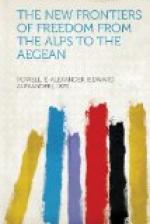Just behind the very tip of the peninsula, on the edge of a superb natural harbor, the entrance to which is masked by the Brioni Islands, is the great naval base of Pola, from the shelter of whose fortifications and mined approaches the Austrian fleet was able to terrorize the defenseless towns along Italy’s unprotected eastern seaboard and to menace the commerce of the northern Adriatic. Pola Is a strange melange of the ancient and the modern, for from the topmost tiers of the great Roman Arena—scarcely less imposing than the Coliseum at Rome—we looked down upon a harbor dotted with the fighting monsters of the Italian navy, while all day long Italian seaplanes swooped and circled over the splendid arch, erected by a Roman emperor in the dim dawn of European history, to commemorate his triumph over the barbarians.
It is just such anomalies as these that make almost impossible the solution, on a basis of strict justice to the inhabitants, of the Adriatic problem. Here you see a city that, in history, in population, in language, is as characteristically Italian as though it were under the shadow of the Apennines, yet encircling that city is a countryside whose inhabitants are wholly Slav, who are intensely hostile to Italian institutions, and many of whom have no knowledge whatsoever of the Italian tongue. The Italians claim that Istria should be theirs because of the undoubted Latin character of the towns along its coasts, because their Roman and Venetian ancestors established their outposts here long centuries ago, because the only culture that the region possesses is Italian, and, above all else, because its possession is essential to the safety of Italy herself. The Slavs, on the other hand, lay claim to Istria on the ground that its first inhabitants, whether barbarians or not, were Slavs, that the Italians who settled on its shores were but filibusters and adventurers, and that its inhabitants, by blood, by language, and by sentiment, are overwhelmingly Slav to-day. The only thing on which both races agree is that the peninsula should not be divided. It was no easy problem, you see, which the peace-makers were expected to solve with strict justice for all. If my memory serves me right, King Solomon was once called upon by two mothers to settle a somewhat similar dispute, though in that case it was a child instead of a country whose ownership was in question. So, though both Latins and Slavs may continue to assert their rights to the peninsula in its entirety, I imagine that the Istrian problem will eventually be settled by the judgment of Solomon.
CHAPTER II
THE BORDERLAND OF SLAV AND LATIN
It was the same along the entire line of the Armistice from the Brenner down to Istria. Whenever the officials with whom we talked heard that we were going to Fiume, they shook their heads pessimistically. “It’s a good place to stay away from just now,” said one. “They won’t let you enter the city,” another warned us. Or, “You mustn’t think of taking the signora with you.” But the representative of an American oil company whom I met in the American consulate in Trieste regarded the excursion from a different view-point altogether.




